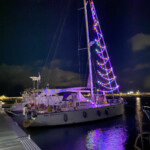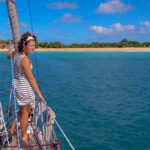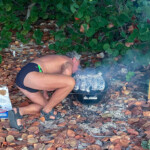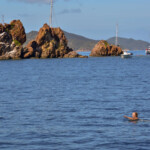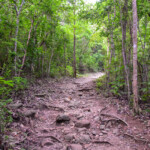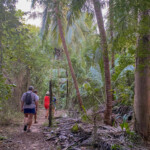Route: Marrigot (Saint Martin)-Tintamarre-Road Town-Pelican Island-Cruz Bay-Cayo Luis Pena-Fajardo-San Juan (Portoryko)
Dates: 31.12.2023-14.01.2024
Miles/ hours: 222 Mm/51h
New Year’s Eve 2023
Before noon, we are preparing the yacht for departure – we are stowing things, doing some last-minute shopping, I am checking out for the British Virgin Islandsn- you can check out a maximum of 24 hours before departure. I pay for the electricity and water used and for the exit check – the man prints out a paper for me to leave. Gosia arrives in the afternoon and we leave the marina around 5 p.m. We sail towards Tintamarre – an island is the reserve. On the way, we wish Happy New Year to our family and friends in Poland – it’s 7 p.m. here, but in Poland it’s midnight. We arrive after dark and stand at the buoy.
We’re assembling the dingy. There are about 10 yachts around us. We’re having a party on a yacht, eating dumplings, drinking delicious drinks. At midnight we watch fireworks on the surrounding islands. Then some of the crew take a boat trip to the beach. It’s nice.
January 1, 2024 – Tintamarre
After breakfast, some of the crew sleeps off New Year’s Eve, and we decide to swim to the island. It looks beautiful from the yacht – blue water and yellow sand. We are not far from the shore, so the trip is not very long. We do some reconnaissance and decide to arrive for a barbecue in the afternoon. Around 5 p.m. we pack our things onto the boat, turn on the Christmas tree lights and sail to the shore. On the shore we find an abandoned large barbecue and picnic benches with tables. We fry the fish on the grill, add potatoes and carrot salad – it’s delicious. We return to the yacht after sunset.
January 2, road to BVI
In the morning, swim in the blue water and have breakfast. In the meantime, the bay is filled with catamarans and motorboats full of people eager to swim. It’s time to set sail. Around 11 we set off further. The wind is not very strong, but from the stern, so we set up the gennaker. In the afternoon the wind dies down and we sail on the engine all night.
January 3 Road Harbor
In the morning we enter Road Harbor – we call the Willage Cay marina, but to no avail.
We enter the marina, but the staff says that first we need to anchor and sail to check-in by pontoon. That’s what we do. First, you need to complete the application on the SailClear website and save the number. Check-in is at the ferry terminal building.
First you have to go to Immigration, leave your passports there, go back to Customs, print and stamp the application, you can check in straight away, then go back to Inigration, from there to the ticket office, take the number from the ticket counter back to Immigration, collect your passports and that’s it. Check-in costs $10 per person for turtles, $15 for yachts, and $13 for round-trip check-in. You can check in via SailClear on the computer in the marina lobby.
In total, I pay $88 for the 6 of us. You can pay by credit card. Tomek and I sail to the marina and decide where we should stand. We return by boat to the yacht and enter the marina.
The plugs in the marina are American and we don’t have them, so we give up the electricity. We connect to the water and wash the deck. I go to pay for the marina – it costs $1.85 per foot – plus water and electricity, shower is $3 per 5 minutes. You can pay by card, but they prefer cash or entering the card number on the contract.
After completing the formalities, we go for a walk around the city – nothing special, left-hand traffic, but the cars have different steering wheels – sometimes on the right, sometimes on the left.
The town is rather small, there are two lines of free city buses, but outside the city there is no public transport on the island – only taxis and rented cars.
American Virgin Islands
We enter Cruz Bay around 3 p.m. We first stop at the anchorage on the right, but it is private and they chase us away.
Check-in
You must register and complete the application in the CBP ROAM application (internet access required). On the left side of the track there is an anchorage for people waiting – you can stand there for a maximum of 3 hours and there are many people willing to do so. It’s shallow – in low water, 2m, so our keel rubs against the bottom, but the anchor stays in the mud. In the application I receive information that my application is being processed. I wait another 20 minutes (in the meantime, we launch the boat and install the engine) and I go with Tomek to the US customs office. There are smaller and larger motorboats everywhere, but eventually we arrive at the quay next to the office – be careful, you have to moor on the right side of the fence. The office is open until 5:30 p.m. First I stand in line, and then it turns out that everyone has to check in, so Tomek quickly checks in (face and fingerprint scan) and goes to pick up the rest of the crew. Everyone checks in 5 minutes before the office closes. In total, the entire check-in, including standing in line and transporting the crew in installments, took us about 1 hour.
The customs officer says we have entered the United States, so we don’t have to check in if we’re going to Puerto Rico. We return to the yacht and move to an anchorage in the neighboring bay.
Stop at the Cruz Bay Reserve
We take a stand. The buoys say it’s a reserve and a night on the buoy costs $26. Long buoy
rope with a plastic thimble – we pull our own line through it. There are flocks of turtles swimming in the bay, and huge fish, attracted by the light, swim around the yacht. You pay for standing on a buoy at the floating toll booth. It’s like a bridge with a flag. Take out an envelope from behind the boxes and write down the name of the boat, date, number of nights, amount and buoy number. The deducted amount is placed in the envelope. The name of the boat and the date are written on the second part of the envelope, which has the same number as the first one, and then it is torn off from the actual envelope, and the envelope with the money is thrown into the box. Locals can pay via the app. We read all this from the folder at the reserve’s tourist information (closed on Saturdays and Sundays).
Cruz Bay
A small town consisting mainly of souvenir shops, bars and restaurants, guesthouses and hotels. It’s a bit like our Władysławowo or Jurata. Traffic is on the left, although cars have steering wheels on the left. Speed limits on signs are in miles/h, and prices in stores for products by weight are per pound (just like 1 kilogram in our country).
We take a little walk around the city.
St. Island John
Nice island, most of it is a reserve. There are plenty of sea turtles, fish, and various birds and lizards on land. The beaches have lovely white sand and blue water. It is green everywhere, there are many forest paths, but there are many private areas with no access. You can hitchhike, there is apparently one bus route, and of course taxis of various sizes and quality.
January 7 Cayo Luis Pena
In the morning we leave the bay at Cruz Bay and sail along the American Virgin Islands to the north of them. We sail a little, a little by engine, the weather is beautiful, there is no heat, and there was even a little rain. When we sail with the engine, we fold out the canopy. A moment before sunset we reach the islet of Cayo Luis Pena near Culebra (this is already the “state” of Puerto Rico) – it is a reserve, you cannot camp there or walk around the island. On the map there are 3 buoys in the northern bay, but in reality there are 2, but in the southern bay – there is already a yacht on one, and we are on the other. They say they are for daytime use only (from sunrise to sunset), but the Navionics description says they tolerate “one-night” stays, so both yachts stay overnight.
January 8, Puerto Chica marina
In the morning we sail out of the bay at Cayo Luis Pena and at the end of the day we reach the Fajardo area.
We enter the Puerto Chica marina and stand in the first available spot. No one answers VHF calls here. When we asked the marina staff if we could stay here, he said that 2 days would not be a problem. I go with Gosia to the marina office – here they speak two languages: Spanish and English, but they prefer Spanish. The lady scans the yacht’s documents, our passports and collects the fee – water is included in the price. Toilets and some marina gates require a card, but we don’t get it. The lady at the marina office dials the number of customs officials and hands over the phone to Gosia. It turns out that the gentleman from Cruz Bay did not call Puerto Rico to inform us that we had already crossed the US borders, but we provided our check-in number and that was enough.
Fajardo
There are 4 marinas in this area:
Isleta Marina – on an island (not for us)
Marina sun bay (too shallow depth)
Puerto del Rey Marina. (way)
Puerto Chica (here we stand)
All are port of entry
A very nice area, many reserves, nice paths, waterfalls.
You don’t really walk here – there are no roadsides, but people are happy to hitchhike. There is no public transport, but Uber works – it is twice cheaper than a taxi.
We went on two trips in subgroups – we went to the lighthouse, and the youth went to the waterfalls.
Another attraction is kayaking on the phosphorescent water, but this attraction must be booked in advance. You can also go on foot to Laguna Grande (about 5 km from the marina) and wait until nightfall. The lagoon glows brilliantly. There is a path on a footbridge that leads to the lagoon and a pipe for sloshing water :-). Then you have to go back along the road in the dark, I recommend wearing reflectors, or rent a car.
January 10, tuna fishing.
We leave the marina in the morning. At a depth of about 70 m, Mateusz unrolls the fishing rod. In a moment it begins to rattle – it means that a fish has been caught. We slow down, reel in the genoa, and Mateusz reels in the line. It’s getting harder and harder – apparently a big fish has been caught. At one point the fish pulls harder and unwinds almost 100m of line. Then it goes easier, but when the fish is at the side, it turns out that 1/3 of it has been bitten off by a large shark. Two more small sharks are hanging around nearby and are biting our tuna. Using the hook, we manage to pull the fish onto the deck – even though it is not whole, what is left is still over 4 kg. Brave Mateusz :-).
Cut the fish and pack it in the fridge. We will portion it out later.
At 5:15 p.m. we enter the marina, no one responds to the VHF call, so we stand longsite at the head of the nearest pier.
January 11, San Juan Bay Marina
You come in the morning and the marina staff and says that we must have a reservation, and the place where we are standing is intended for large ships. During the conversation, however, it turns out that there is a vacant place where we can move and stay for 10 days. We get settled and then I go to the office to take care of the formalities. It turns out that everything (both booking and payment) can only be done via dockwa.com. I go back to the yacht and click on the reservation. Then I go to the office a second time. It turns out that after the payment is approved, it cannot be collected because there is an incompatibility of the protocols between the banks. I go back to the yacht and connect another card.
Meanwhile, Tomek finds lithium batteries in San Juan. Me and Gosia are going to get a permit for Mona Island. It turns out that from December to the end of April is the hunting season and you can neither enter the island nor swim near it. We’re going back to the yacht. Tomek is struggling with batteries.
An attempt to pay by card online fails (the store does not generate the 3D secure code and the bank requires it). We’re going to the store – the batteries are already waiting for us. We pay on site by card. It’s already dark, so we call an Uber and grab the batteries.
San Juan
The capital of Puerto Rico. It’s a big city, although the old town is worth visiting. You can also go to a nice beach with palm trees near the marina. You can get around the city by public transport (there are small and large buses as well as the metro). A ride on a “large” bus costs $0.75 per ride – you pay with coins at the machine at the entrance to the bus, or you can punch the card at the metro station. The coin machine does not give change. Another option is Uber – a bit cheaper than a taxi, and the price depends on the distance and time of day. You can rent a car, but including insurance it costs about $60 per day – the starting price is $10, plus 3 different taxes and insurance + the same taxes.
Puerto Rico
The island belongs to the USA, so if we checked in in the US Virgin Islands, we no longer have to go to Puerto Rico, but we need to tell the first port in Puerto Rico that we are already checked in (it is worth writing down the check-in number from the ROAM application). By car, it is worth visiting a cocoa plantation (only on weekends), El Yunque National Forest – and not on weekends – then you have to wait in a car queue, and people on foot are not allowed 🙁
Another place worth visiting is Bosque Estatal de Guajataca with caves – you need to take a flashlight and comfortable mud-resistant shoes.







